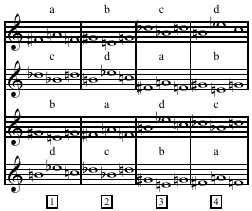Related Research Articles
In music, a quartet is an ensemble of four singers.

Milton Byron Babbitt was an American composer, music theorist, mathematician, and teacher. He was a Pulitzer Prize and MacArthur Fellowship recipient, recognized for his serial and electronic music.
Alfred Whitford (Fred) Lerdahl is the Fritz Reiner Professor Emeritus of Musical Composition at Columbia University, and a composer and music theorist best known for his work on musical grammar and cognition, rhythmic theory, pitch space, and cognitive constraints on compositional systems. He has written many orchestral and chamber works, three of which were finalists for the Pulitzer Prize for Music: Time after Time in 2001, String Quartet No. 3 in 2010, and Arches in 2011.
Mario Davidovsky was an Argentine-American composer. Born in Argentina, he emigrated in 1960 to the United States, where he lived for the remainder of his life. He is best known for his series of compositions called Synchronisms, which in live performance incorporate both acoustic instruments and electroacoustic sounds played from a tape.
Peter Talbot Westergaard was an American composer and music theorist. He was Professor Emeritus of music at Princeton University.
Richard G. Swift was an American composer and music theorist.

Composition for Four Instruments (1948) is an early serial music composition written by American composer Milton Babbitt. It is Babbitt's first published ensemble work, following shortly after his Three Compositions for Piano (1947). In both these pieces, Babbitt expands upon the methods of twelve-tone composition developed by Arnold Schoenberg. He is notably innovative for his application of serial techniques to rhythm. Composition for Four Instruments is considered one of the early examples of “totally serialized” music. It is remarkable for a strong sense of integration and concentration on its particular premises—qualities that caused Elliott Carter, upon first hearing it in 1951, to persuade New Music Edition to publish it.
The Group for Contemporary Music is an American chamber ensemble dedicated to the performance of contemporary classical music. It was founded in New York City in 1962 by Joel Krosnick, Harvey Sollberger and Charles Wuorinen and gave its first concert on October 22, 1962 in Columbia University's MacMillin Theatre. Krosnik left the ensemble in 1963. It was the first contemporary music ensemble based at a university and run by composers.
Jason Eckardt is an American composer. He began his musical life playing guitar in heavy metal and jazz bands and abruptly moved to composing after discovering the music of Anton Webern.
In music, a duodecet—sometimes duodectet, or duodecimette—is a composition which requires twelve musicians for a performance, or a musical group that consists of twelve people. In jazz, such a group of twelve players is sometimes called a "twelvetet". The corresponding German word is Duodezett. The French equivalent form, douzetuor, is virtually unknown. Unlike some other musical ensembles such as the string quartet, there is no established or standard set of instruments in a duodecet.
Composition for Twelve Instruments is a serial music composition written by American composer Milton Babbitt for flute, oboe, clarinet, bassoon, horn, trumpet, harp, celesta, violin, viola, cello, and double bass. In it Babbitt for the first time employs a twelve-element duration set to serialize the rhythms as well as the pitches, predating Olivier Messiaen's (non-serial) "Mode de valeurs et d'intensités", but not the Turangalîla-Symphonie (1946–1948), in which Messiaen used a duration series for the first time in the opening episode of the seventh movement, titled "Turangalîla II".
String Quartet No. 2 (1954) is the second of six string quartets by the American composer Milton Babbitt.
String Quartet No. 3 is the third of six chamber-music works in the string quartet medium by the American composer Milton Babbitt.
String Quartet No. 4 is the fourth of six chamber music works in the string quartet medium by the American composer Milton Babbitt.
String Quartet No. 5 is the fifth of six chamber music works in the string quartet medium by the American composer Milton Babbitt.
All Set, for jazz ensemble, is a 1957 composition for small jazz band by the American composer Milton Babbitt.
Robert Miller was an American pianist and attorney.
This is a partial discography of composer Charles Wuorinen.
Matthew Jonathan Greenbaum is an American musician, composer and author.

Myth and Mythopoeia is an album of contemporary classical music composed by John Zorn and featuring a piece for string quartet and soprano, one for solo cello, one for a trio of piano, violin and cello, one for a duo of violin and cello and one for full ensemble, which was released on the Tzadik label in June 2014.
References
- ↑ Mead 1997, p. 117.
- ↑ Colson 2012, p. 2.
Sources
- Colson, Daniel (Spring 2012). "The Babbittian Question". Music Theory Spectrum . 34 (1): 2–4. doi:10.1525/mts.2012.34.1.2.
- Mead, Andrew W. (Summer 1997). "Still Being an American Composer: Milton Babbitt at Eighty". Perspectives of New Music . 35 (2): 101–126. doi:10.2307/833645. JSTOR 833645.